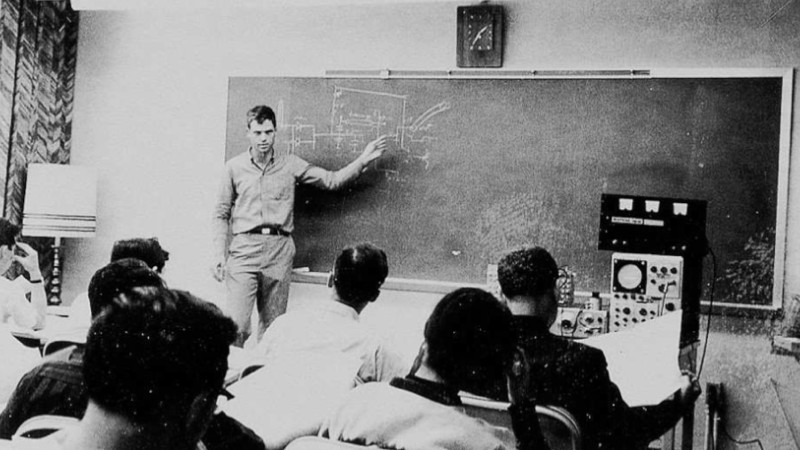We’re sorry to say that back in May we missed the passing of Walter LeCroy, the man whose name appeared on some of the most desirable and higher-spec oscilloscopes to be found. If you’ve never used a LeCroy ‘scope then you’ll still have benefited from his work, as a pioneer of storage oscilloscopes even the more modest instruments which now grace our benches owe much to his legacy.
The linked article about his life comes from the successor to his company, and describes his early experience in scientific instrumentation and in particular in the field of high-energy physics,before the development of the first digital storage oscilloscopes. In particular it mentions the 1971 “Waveform Digitizer”,a device that used a transmission line and a series of sample-and-hold circuits to grab and digitize a sequence of readings with a single ADC. It goes on to describe the model 9400 series from the 1980s which with its successors are probably are what come to mind for many of us when thinking of a LeCroy ‘scope, the familiar big square box with integrated computer-style CRT, floppy drive, and small printer.
Here in 2023 it’s not beyond the bounds of possibility to design your own digital oscilloscope simply by pairing a fast microcontroller with an appropriately expensive ADC chip. To look back at the effort required to produce one with a high bandwidth using 16-bit microcomputer parts and 1980s silicon is to be reminded that we stand upon the shoulders of giants.
Thanks [Daniel Valuch] for the tip.















I have 2 LeCroy O-scopes in the garage 100MHz digital sampling.
Total cost $75
Stop bragging. I’m jealous.
You can get decent older lecroys off ebay for very reasonable prices. I have four, all from ebay, and three showed up completely functional. They’re also fairly easy to repair, especially the 9300 and 9400 series, and there’s an active groups.io community who have an enormous amount of experience fixing older lecroys.
I looked a lot at siglents and rigols, and while their weight and size is pretty attractive compared to a 94xx, the higher bandwidth versions of the 94’s have some pretty impressive features considering the price. Most people don’t need “trigger only when the channel A pulse is between 5 and 40 nanoseconds late and channel B is high”, but I do, so it’s really nice to have something capable of doing that.
I’m sorry for being so rude in posting that.
The article is about the accomplishments of a man who helped many others in reaching new goals and his love for nature, sciences, and others.
Lecroy’s company was (and still is) a most professional company, that I had the opportunity to work with as a supplier. They really were at the top of their game. The “Gemini Project” was a milestone!
Thanks, Guys!
The linked article was fascinating and provided great insight into the man and the company. LeCroy saved my bacon so many times – even If there was no Nobel. When everything else failed, I knew the LeCroy could provide answers.
And if you question his use of a unijunction, remember that the 555 hadn’t been invented in 1960, kid.
I agree, the linked article is worth reading, including the “read more” links!
The 9400 that I demanded for us to get in 1987 instead of HP that was suggested was fantastic. The 9400 was a key asset for years.
When I did switch job I got a 9314 in 1993 I actually selected the car to purchase depending if the transport box fitted or not in the trunk…
Well now I have got a 9354AL, 9354M and a WR6200A, two LW420 and a 9384CL that need some TLC.
Still love LeCroy products
Walter LeCroy, with his game-changing products showed me what can be created, and measured with well designed state-of-the-art equipment. Thank You Walter LeCroy.
I’ve been using a 9414 for a decade at home and it’s been absolutely bombproof, but finally broke down and upgraded to an LT374, in part because I think it’s so cool that it has a tiny little functional thermal printer in the top. The 94xx four channel scopes had some minor limitations that bugged me, like if you have a lot of parameters showing, like you’re having the scope show the frequency, duty cycle, peak to peak amplitude, it slows down a lot and sometimes doesn’t display all that accurately, although the trigger is still correctly capturing. (As in, I have an extremely low duty cycle peak on multiple channels, and it’ll show missing peaks, even though if I set it up to only trigger on missing peaks it doesn’t find anything.) The processor just can’t keep up with the demands. The LT374 has a powerpc processor, and has no problem with anything I’ve thrown at it so far.
Yes, those were the days! I was a salesman for LeCroy when the 9400 came out. I started with the High Energy Physics products, but then found we were selling more transient digitizers than HEP. Then the 9400 was introduced and it was amazing. A simple demo and the customer was sold. High speed, long memory, push button math on the screen! Tektronix had nothing like that for awhile. We sold them like hotcakes.
The link to the biography was spot on.